#Del learns digital painting
Text
✧ INTRO POST !! ٩(๑❛ᴗ❛๑)۶ 🕊
Heya! I'm Fluutter, 17 y.o ִֶָ
Argentina, she/her !! ♥︎ ⊹
lgtb+ (bisexual) 🌷 ꪆᰰ
eng/esp 🦋
︶꒷꒦︶ ꒦꒷꒷꒦ ︶꒷꒦꒷︶
I'm a digital artist who draw original characters, genshin impact, countryhumans and sometimes fnaf. I post videos about my art on tiktok and other posts on twitter and instagram. 🩰
I usually draw with pastel or slightly saturated colors, and I like to learn new things all time and improvise <3
I used medibang paint to draw but currently I use clip studio paint 🎨 ⊹
I'm learning animation as a hobby and I dream of making graphic stories. I love light blue and Cinnamoroll, history and literature~ 💭
Commissions coming soon!
❘❙❚❙❘❙❙❚❙❘❙❙❘❙❚❙❘ ♡゙
DNI !! nft, crypto, proshippers, lgbtqiphobics!
2 notes
·
View notes
Text

Ambrosia project
(Español ⬇)
Old art: 2019
This is the sketch that made me have an idea: the Ambrosia project. Although, is not the first art of the project.
What's the Ambrosia project? Let me show you these two presentation images for you to know:
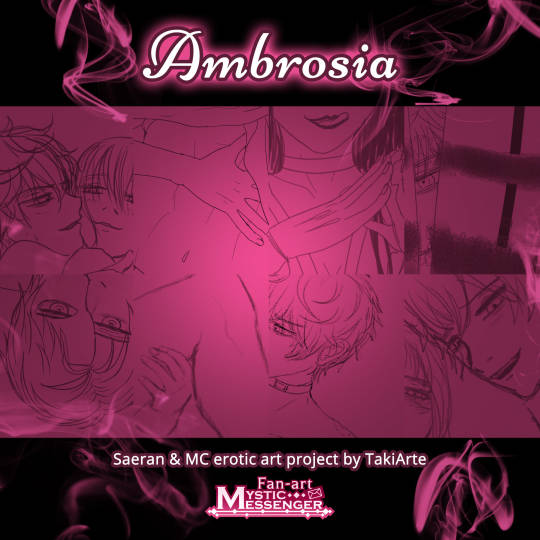


The reason why the art pieces of this are still not uploaded here is this one (another post where I explained some things about my hiatus). And well, I'm only gonna upload previews since 🙄 Tumblr and the d*mn 🔞 purge.
You will find the Ambrosia arts under the Ambrosia tag in my profile, with links to the full versions. And you can also support me by buying the HQ versions of the arts on my Gumroad or buying me a ko-fi. I'm gonna be very grateful!
If you wanna take a look, you can see the first Ambrosia art in my Pixiv here, my +18 Twitter here and/or buy it on my Gumroad, here.
The Ambrosia project is not finished, only on a hiatus. If you read the post I shared as reasons for the late upload of the pieces here, you will know I'm not in MM fandom anymore. So, that's why I have unfinished art. But I hope I'm gonna find the energy to continue some of them (there are nine finished pieces).
That project made me learn and achieve things that surprised me as an artist and made me know for SURE that er0tic art is something I LOVE, and I'm not gonna hide it anymore. If you like it, good. If you don't, I'm sorry for you, you miss it.
I hope you enjoy this project as much as I do in sharing it ❤
.
——————————
.
Este (el de arriba de todo) es el boceto que me hizo tener una idea: el Ambrosia project o proyecto Ambrosía. Aunque, no es el primer arte del proyecto.
¿Qué es el Ambrosia project? Arriba, junto a la descripción en inglés, encuentran la explicación en español de qué es.
La razón de por qué estos artes aún no han sido subidos aquí es esta (otro post donde hablo además de mi hiatus). Y bueno, solo voy a poder subir previews porque 🙄 Tumblr y su maldita purga 🔞.
Vas a encontrar los artes de Ambrosia bajo la etiqueta Ambrosia en mi perfil, con los links a las versiones completas. Y también puedes darme apoyo comprando las versiones HQ de los artes en mi Gumroad, o comprándome un ko-fi. ¡Estaría muy agradecida!
Si quieres dar un vistazo, puedes ver el primer arte de Ambrosia en mi Pixiv aquí, mi +18 Twitter aquí y/o comprarlo en mi Gumroad aquí.
El proyecto Ambrosia no está acabado, solo en hiatus. Si leíste el post que compartí sobre las razones por las que me tardé en subir artes aquí, sabrás que no estoy más en el fandom de MM. Así que, por eso es que tengo arte sin acabar. Pero espero poder encontrar la energía para continuar algunos de ellos (hay nueve piezas ya terminadas).
Este proyecto me hizo aprender y lograr cosas que me sorprendieron como artista y me hicieron saber con seguridad que el arte erót1c0 es algo que AMO, y no voy a esconderlo más. Si te gusta, bien. Si no, lo siento, tú te lo pierdes.
Espero disfruten de este proyecto tanto como yo en compartirlo ❤
——————————
Game: Mystic Messenger
Characters: Saeran and MC.
The characters belong to their creators
© Cheritz
TRADITIONAL ART
Graphite pencil
DIGITAL ART (for Ambrosia previews)
Photoshop & Clip Studio Paint
——————————
Find me on / Encuéntrame en: linktr.ee/TakiArte
#ns/fw#Ambrosia#Saeran x MC#Saeran Choi#Unknown#Suit Saeran#Saeran#Mystic Messenger#Mint eye#MysticMessenger#fanart#otome#Ray#MM#saeran mystic messenger#unknown mystic messenger#MysMe#SuitSaeran#mm saeran#nsft#nsftumblr
3 notes
·
View notes
Text
Weekly Blog #1
I've stated many times that my biggest idol and inspiration is Guillermo del Toro. He inspires me in everything he does.
3 inspirations of del Toro: Walt Disney, James Whale (director of Frankenstein 1931), and Charlie Chapman.
3 inspirations of Walt Disney: Charlie Chaplin, Buster Keaton, Winsor McCay
3 Inspirations of James Whale: Paul Leni, Paul Wegener, Robert Weine
3 Inspirations of Charlie Chapman: Max Linder, Dan Leno, Fred Karno
I would like to research/learn:
Metal casting
Wood carving
Fine miniature creation
Manuscript facsimile creation
long-form creative writing
medieval customs and culture
digital painting techniques
creation of fictional languages (conlangs)
video game creation
voice acting
0 notes
Text
Descentralización del Conocimiento: Nuevas Formas de Legitimación Educativa en la «Era Digital i de la Inteligencia artificial» –
See on Scoop.it - E-Learning-Inclusivo (Mashup)
Android; Artificial Intelligence seated looking at a blank canvas with exit light in the room and a stack of canvases in the foreground. Painted on heavy paper; using acrylic paint and pencil line. Painted for the cover of Politico Europe 2023 Juan Domingo Farnos ¿Por qué esta transformación que va del poder y el control…
0 notes
Text
Star Wars Day 2017 @ WSU | How a simple nerdy event became educational
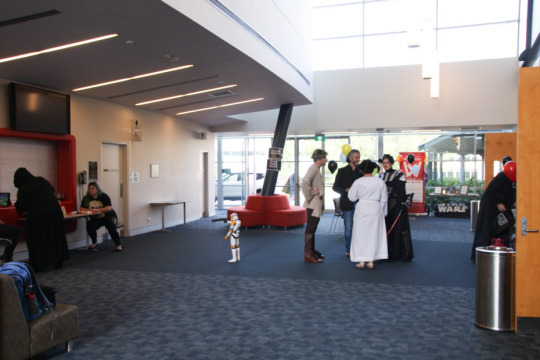
Star Wars Day has hit Western Sydney University and this year, the celebration of this Sci-Fi event has gone bigger as Western Sydney University Nerdfighters has partnered with Information Technology and Digital Services (ITDS) to create a bigger event than ever before. This year, both students and staff worked together to not only celebrate the film franchise but to also discuss on how Star Wars and the world of science fiction can help innovate the future and what we can learn from them.
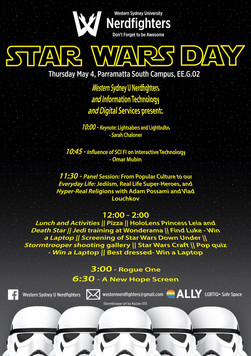
The event ran for the whole day, starting from 10AM at the EE Building and once you entered, you could see the hard work and effort both the Nerdfighters team and IT staff have made. There were two virtual reality booths, one to visually project an image of the Death Star and the other to do a VR Lightsaber training, an arts and crafts table, and other activities that attendees could participate.
Emma Del Dot, the club president of Nerdfighters states that “We’ve got interest from academics and students this time. Its really great and I’m really excited about it”
The event was heavily advertised via the university’s social media in hopes to have plenty of staff and students to come over and celebrate this occasion. According to Jo Deeker (the strategic, planning and portfolio manager in IT) and Sarah Chaloner (the deputy chief information and digital officer), they both contacted the Nerdfighters to ask if they want to work together for this event after hearing that the club has something planned via Facebook.
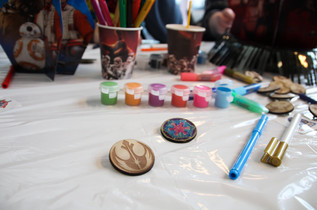
“We were already planning something this year but we heard that the Nerdfighters were planning something at the same campus. So we contacted the Nerdfighters and asked if we can please work together to put the event on” said Sarah.
Isabella Bowdler came from UTS to attend the event after being told about it via her lecturer. She said “I thought I was going to be a bit bored because I’m not a huge Star Wars Fan, but I found the talks really interesting because they didn’t just talked about star wars. They talked about how it’s still relevant in modern day, and talked about sociology and stuff like that”.

“I think what science fiction does is that it paints the picture of the future, and the scientist and the engineers come together and go ‘ah, I know how that looks like, I’m gonna create it” Sarah Chaloner says.
“I think one of the biggest impacts that I’ve seen recently is from Star Trek and particularly the touch screen technology” Jo Deeker says. “In 1967, they were pushing buttons on the screen and it was completely unrealistic. And yet 10 years ago smartphones came out and it was amazing”
“Think about this, the things that you take for granted, every time you go through a sliding door, they have it in the shopping centres, and even in the university, that concept first introduced to the public in the original Star Trek series” Sarah Chaloner says. “Every time I go through a sliding door now, I make that noise in my head… and sometimes I make it out loud, because I remember watching on television thinking ‘That’s amazing, wouldn’t it be cool if you walked up the door and it just opens?’”.
The staff believes that its possible to make fun and learning co-exist and there is a lot that we can learn from science fictions and it’s possible to weave them in to the academic world. This event gave them the opportunity to tell their stories on how Science Fiction has influenced them in a huge way that it now intertwines to their academic field.
The key message that can be taken home from this event is that Science Fiction inspires people to innovate and create better things for the future. It can influence on what plan to do for the future and it can improve on how we see our world today and tomorrow.
“Science Fiction just provides the ideas. They just paints the picture on what the future might look like, or could look like, or should look like. And it’s our jobs as engineers, scientist, technicians, and artist to make that real” said Sarah Chaloner.
Star Wars Day in WSU was truly an amazing event I’m looking forward to see what Nerdfighters have install for the future.
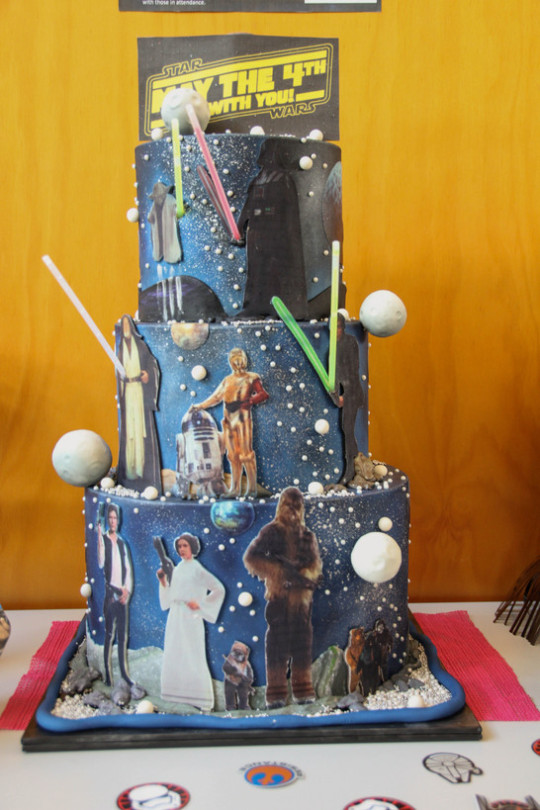
Writer’s note: Article was written on May 5 2017. It was submitted for W’sup but nothing was said about it so I published it here for the time being.
Official Star Wars Day Gallery via Facebook
0 notes
Photo
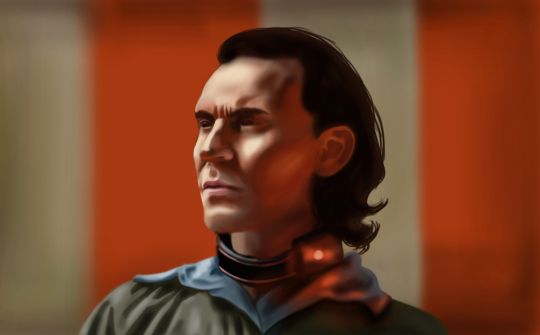
More digital painting practice! Digital certainly is faster and means I can get in more practice with colour. Colour is fun!! :)
#Del learns digital painting#loki#loki art#loki fanart#fanart#art#my art#loki trailer#loki series#digital art#portrait
60 notes
·
View notes
Photo

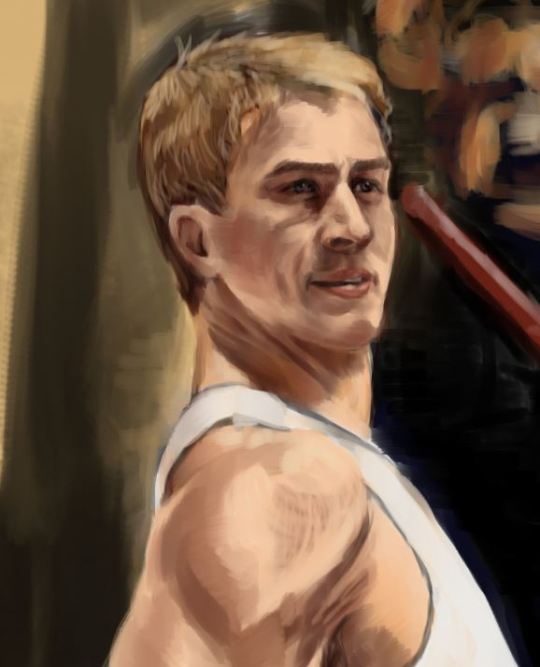

More Pacific Rim studies
#I love this movie so much#these two are both so fun to paint#and I had a lot of fun messing with the brush and stuff#learned a lot#I hope#pacific rim#digiital art#digital painting#mako mori#rinko kikuchi#raleigh becket#charlie hunnam#screenshot repaint#screenshot study#guillermo del toro#color symbolism#red#raleighs neck looks so weird#and the far side of both of their faces look off#its a hard angle for me#idk#im still like super proud of this#which was just supposed to be quick studies#but if theres faces involved i get so caught up in the details#but it was fun so :)#irene's art#he-said-irene's art
87 notes
·
View notes
Text
Bibliography and Visual References
When I began creating San Simeon, I wanted a setting where I could play out a legacy challenge themed to Filipino history. I've always wanted to try a historical legacy challenge and this was the story I was most confident in telling. And while it would be a lot of work, at least I was working from a place of familiarity. Or so I thought. Turns out I had a lot to learn.
I did a lot of research on colonial (and later, precolonial) history to get the aesthetic right. Illustrated works were crucial since the Sims 3 is a visual medium that favored a lot of detail. I also needed to know how societies of the time worked so I could adapt them into game play. I can’t put in everything, of course, but I try to adapt as best I can.
Here’s a general list of the sources I used to recreate my historical builds and settings, plus a few works that I’d recommend for those interested in Philippine history. Note that I have a strong preference for visual works.
Period Documents
Laguna Copperplate Inscription (900): The earliest surviving written document found in the Philippines whose incidental details provide a look into the lives of the aristocracy of the period. The English translation can be found here.
Relazione del primo viaggio intorno al mondo (c. 1524 - 1525) by Antonio Pigafetta. Known in English as The First Voyage Round the World, this was the first published account of European contact between Europeans and the people of what would become the Philippines. Prior to the Copperplate Inscription’s discover this and similar accounts from later Spanish chroniclers were the primary sources of what Filipino people were like before the conquest. You can read Lord Stanley’s translation on Wikisource or Robertson’s translation on Project Gutenberg.
Boxer Codex (c. 1590): A Spanish illustrated book showing the appearance and clothing worn by the inhabitants of East and Southeast Asia during the late 16th Century, with a focus on the indigenous inhabitants of the Philippines. Images can be viewed from the Indiana University Digital Library or Wikipedia.
Sucesos de las Islas Filipinas (1603) by Antonio de Morga. This was an official chronicle of the country from the early 17th Century, providing official accounts of both prominent conquerors and indigenous leaders and provides a glimpse of life during the early days of the conquest. This book was important in Dr. Jose Rizal’s own analysis of Philippine history and he annotated his own copy extensively. The English edition is available from Archive.org.
Bankoku Sozu (c. 1671): This name refers to a type of world map first published in Japan during the Tokugawa shoguns came to power. These maps, while stylistically Japanese, used techniques learned from European scholars. The maps also included a collection of images representing the national costumes of people from the countries of the world. A few of these maps depict colonial-era indigenous Filipinos. Notably, the man is wearing stockings, indicating the couple depicted came from the native nobility (principalia), who were likely to imitate the fashions of the colonizers. See two examples from the University of British Columbia and Wikipedia.
Carta Hydrographica y Chorographica de la Yslas Filipinas Manila (1734): The period map contains illustrations of daily life in the Philippines during the 18th century, including depictions of what the people of the time, from the natives and foreign traders to the Spanish and Mestizo elite, had been wearing during that
Catalogo alfabetico de apellidos (1849), by the administration of Governor General Narciso Claveria y Zaldua: This is a compilation of period surnames from 1849, assigned to various indigenous Filipino families who lived in the Spanish-controlled areas of the country.
Period and Period-Inspired Art
Huang Qing Zhigong Tu (c. 1761), by Xie Sui: Also known as Paintings of Tributary People of the Great Qing, this is an ethnographic compendium of tributary peoples of Qing Dynasty China, which includes depictions of people within the Chinese Empire, its neighbors that pay it tribute (hence, “tributary”), and foreign nations in Europe. The book depicts two regions now found in the Modern Philippines. The first are a man and woman from the Sulu Archipelago, which had at the time been a separate nation in constant conflict with the Spanish. The second a depiction of a man and a woman from what is identified as Luzon. While the woman wears clothing that can be clearly identified with the native aristocracy, the man wore European clothes, indicating that he is a European colonizer (and confirmed within the text).
The full illustration is shown on this link from the National Palace Museum in Taiwan. This article, meanwhile, shows important highlights of the document and provides commentary on it in English (and singles out the pair of Filipinos). You can also download the full text and images as a .pdf for free here (the link to buy is for a hardbound copy).
The illustrations of the artists of the Malaspina Expedition (c.1792): These images depict Manila and various parts of the Philippines from before the 19th century. As most images of the Philippines in the popular consciousness are based on mid- to late 19th Century images, these prints are a valuable source of information on 18th and Early 19th Century Philippine architecture from the British occupation to the time of Napoleon’s conquest of Europe.
Tipos de País (folk costume) paintings by Damian Domingo and others (1820s onward): There are many of them. I frequently find them in many of my sources. They’re a useful reference in creating depictions of 18th through 19th Century clothing in the Sims. You can see a sizable collection of them on Wikipedia.
The works of Fernando Amorsolo (1914 - 1972): Amorsolo is among the most beloved artisans in living memory and his oil paintings provided a glimpse of what turn of the 20th Century Filipino life was like. His portrayals are quite idealized and romanticized, however, which means you have to take their depictions of happy peasants in bucolic environments with a grain of salt.
The Visual Noli me Tangere by Leonardo Tayao Cruz (2002 - 2006): These are a series of paintings patterned after the chapters of Rizal’s seminal novel. Each painting is a depiction of the Philippines in the mid-1800s. You can view the paintings here.
Photographs and Image Compilations
The Manila Daguerreotypes (c. 1840s): These are the oldest photographs taken of what would become the modern Philippines and show Manila as it was in the 1840s. These were taken by an anonymous photographer who was a guest at an American trading house somewhere in Manila. View these photos at Filipiknow.net.
Various photographs and prints from the collections of John Tewell: If you want a one-stop shop for various period images, look no further. Included are various images of Manila during the turn of the century and copies of the urban cityscapes of the Malaspina Expedition.
Reputable Web and Social Media Sources
The Time Trekker: The Time Trekker is a Facebook page run by one of my old professors in college, Mr. J.P Abellera (notably, he was also involved in the production of Quezon's Game). Included are photographs he and other like-minded history lovers took of heritage structures across the country.
Project Vinta: An official page of the Ramon Magsaysay Foundation, the page shares various events and facts on the history of the Philippines. It has a series called "On This Day" where it shares the stories behind major events that took place on a specific date in Philippine history.
The National Quincentennial Committee: This government-sponsored organization is responsible for the 500th anniversary of Spanish contact and the events surrounding it, including the Battle of Mactan. The committee also provides plenty of resources on precolonial Filipino societies on the eve of contact.
Renacimiento Manila: Renacimiento Manila focuses on heritage preservation within Manila itself and is involved in a digitized scale reconstruction of the heritage structures both extant, reconstructed, and lost to recreate Manila as it may have appeared on the eve of the Second World War. The page and the organization behind it also advocate for the in situ preservation of heritage structures. They also provide easy to understand resources on architectural styles and historical fashion, albeit restricted to Manila.
The National Museum of the Philippines: Physically, the National Museum is free to enter. The institution provides several exhibits on various aspects of Philippine history and culture from the earliest part of human prehistory to the colonial era. Its exhibits also encompass natural history and ecology, so you can get to know what life was like before the first modern humans arrived in the Philippines. Their Facebook page is a good place to learn about various items (from fossils to historical artifacts) in their collection from home.
The Aswang Project: This website and its associated YouTube channel is an excellent beginner’s resource on the mythologies (note the plural) of the Philippines, which includes not only the stories associated with indigenous religions but also mythical creatures in pre- and post-colonial Philippine lore.
Period Literary Fiction
Noli me Tangere (1887) and El Filibusterismo (1891) by Dr. Jose P. Rizal: It just wouldn't be right not to include these two novels. Many Filipino literature nerds fell in love with the novel in high school. It was required reading for a good reason, too, as it illustrated the contemporaneous challenges faced by the native and mixed-race Filipinos during the terminal end of Spanish rule. I’ve linked to digital copies of the English translations, which are available for free on Project Gutenberg. I have the comic.
Reference Works
The Philippine Islands: 1493 - 1898 (1906), by various authors, edited by Emma Helen Blair and translated by James Alexander Robertson: This is a compendium of various documents related to the history of the Philippines translated into English. The books as compiled come in various volumes, some of which can be read from Project Gutenberg.
Filipinos in China Before 1500 (1989) by William Henry Scott. This annotated document provides a glimpse into the complex history of imperial China’s relations with the various states in the Philippines before Spanish contact. This provides a good historical snapshot of the Philippines at the time as it provides attestation for various states in the Pasig River Delta, Butuan, Pangasinan, and the Visayas. It can be read from the University of the Philippines - Dilliman website.
Looking for the Prehispanic Filipino (1992) by William Henry Scott. This is a collection of essays by Scott, which touches on the details of precolonial life and the ways that the historical records during the early contact period can be re-examined to paint a more accurate picture of life before and during the advent of the Spanish conquest. A copy can be found on Archive.org.
Kasaysayan: The Story of the Filipino People (1998), edited by Jose Y. Dalisay, Jr.: This is an encyclopedic compendium consisting of works written by various authors on different socio-political events in the Philippines from ancient prehistory to the 1986 People Power Revolution that ended the Marcos regime. The articles were written in-depth and provide insight and opinion into how precolonial, colonial, and post-colonial society worked at the time.
Fun fact: Many of the aforementioned illustrations can be found in these books’ pages.
Museum Exhibits
Various exhibits at Bahay Tsinoy: The heritage center’s many exhibits showcase the history of the Chinese settlers in the Philippines and the impact that Chinese Filipinos had in shaping the country’s culture, language, and political history.
Various exhibits at the Ayala Museum:
Gold of the Ancestors: This is an interactive exhibit showcasing the many gold grave artifacts (most of them grave goods) of the pre-Hispanic native aristocracy. The gold displayed the artisanship of the precolonial goldsmiths and the wealth of the lowland city-states of the period.
A Millennium of Contact: This exhibit provides excellent historical background for the contact that Ancient Filipinos had with the Chinese, as told through the ancient Filipino aristocracy’s favorite luxury import: fine porcelain.
Art and the Order of Nature in Indigenous Filipino Textiles: This exhibit provided a basic idea of how indigenous textiles worked. This is vital to creating and improvising the art and textiles of the pre-colonial inhabitants.
The Diorama Experience: Perhaps one of my biggest sources, rivaling Kasaysayan. These images provide a realistic depiction of many of the major milestones of Philippine history.
Remember: It's important to rely on multiple sources of good repute, so that you can compare details, spot possible errors, and make a fair assessment. As my research continues, expect the bibliography to expand.
40 notes
·
View notes
Text
My new new years list
TW: mental health crisis and social anxiety
This month was wild. I barely went out or went to see my friends during the pandemia (last year I saw one friend twice), but I end up seeing some friends for a week this month. It was great, then I guess I was triggered or something, but after that I just felt unstable and mentally awful. I slowly started to recovery, but I went to a job interview, it was awful, because I have social anxiety and then I was on the path to hit the rock bottom.
And then I was like "goddamn, I urgently NEED to do something" and I created a huge detailed list about why and how should I recovery, what to do and where I want to be in the future. I'm more stable and better now.
The list about how I want to be is basically more specified than this one list and I REALLY will try harder on everything. Actually I'm not a proactive, productive, someone who really put effort and who face the fears, but I want to change that, I don't want to be this kind of person anymore.
I hope I can focus on why I want to be a better version of myself, how to do it and really do it.
1 Be fluent in spanish
Yo solamente asistí Elite, yo no participé de ninguna clase de español, porqué yo no sé hablar español. ¡Sí! Buenísima razón, ¿eh?
¡Yo no solamente intentaré, pero yo cambiaré esa mentalidad!
Oh, na verdad el maestro me sacó del grupo, tal vez porqué yo no participé tampoco me justifiqué.
2 Eat 2 new foods and 5 days of no eating meat
5 days no meat
Bean (I don't know the name, but I just eat the broth part, I don't properly eat the bean bean, because I hate it since I was a child)
Pea
Guacamole
Squid
Be comfortable in french
3 Work with design
I started the graduation on Graphic Design, I wish I could be a trainee, but I'm only able to be that after the second semester.
But I had a job interview and was awful.
I'm thinking about to try to be a freelancer (as I said, I'm not proactive + social anxiety)
4 Read 10 books and get used to read just after going to bed:
I finished Call Me By Your Name (english). I'm reading a book for college called The Story of Art (by Gombrich. In portuguese) and I started to read 1984 (in portuguese).
I want to try to read 15 pages every day, it would be way better than the way I'm doing now (the current way is: never read).
5 Be more active in Esperanto-movado and study about it:
I'm doing okay, putting some effort and working on BEJO. But I want to be more social with esperantists and study about the language and learn grammar.
6 Exercising every week (and run a bit):
I did, but I want to do it almost every day.
7 Watch 4 movies or series for month and put the less famous on doesthedogdie. com: at least 1 doc or biographic movie.
1 Chicken Little (USA, 2005)
2 Willy's Wonderland (USA, 2021)
3 Feel Good (UK, 2020-2021)
4 Elite (Spain, 2018-2021)
No biographic or doc.
8 Write down 4 dreams every month.
I wrote a lot.
9 Draw 6 dreams this year.
Guess what? I didn't.
10 Sketch, draw/paint on paper AND digital every month:
I sketch, drew, paint, made digital art, embroidered.
11 Draw on notebook almost everyday:
I almost did.
12 Finish 3 arts for month:
2 embroideries, 1 canvas, 2 digital art.
13 Learn anatomy and draw romantic couples:
I studied.
14 Post a chapter of fiction every month:
I didn't.
15 Start posting fiction in Esperanto (please):
Nenio... denove. Mi eĉ ne verkas aŭ volas verki, mi ne scias, ĉu mi vere volas fari tion ĉi aŭ ne.
16 Take care of myself
I didn't, I mean, at least I tried (and was able) to not come back to my most awful cope mechanism I once had.
Sadly my bad cope mechanisms came back for a while lol
17 Be more sociable AND better at talking, in general:
I guess I'm trying, but I don't know if I'm really getting better lol
8.5/18 = 50%
13 notes
·
View notes
Text
King Kong (1933); AFI #41



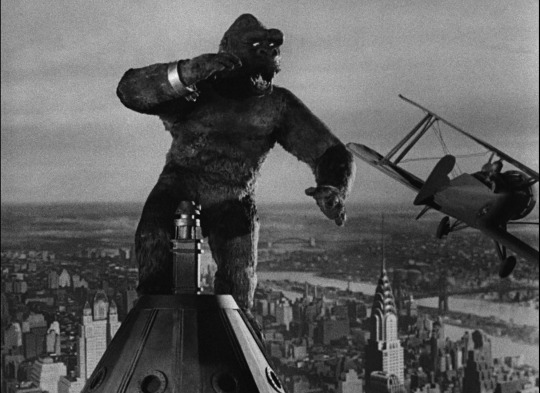
The latest movie for review was the one and only creature feature on the AFI top 100 list, the iconic Kong Kong (1933). This was the equivalent of a blockbuster for the time as it was first presented at Radio City Music Hall for 4 days and all shows were sold out. The film incorporated layering technology that had never been utilized before, which I assume made the experience of watching in a 9,000 attendance capacity crowd on a 30 foot screen an amazing experience. The film did not win any awards, but has since been recognized as a defining film for special effects in Old Hollywood. I was able to track down a version of the movie with commentary by Ray Harryhausen and I want to discuss what was revealed about the film production, but we should do a quick summary of the film first. I will not go into too much detail since the film has been remade three times now and most everybody knows the story, but I still need to do the standard...
SPOILER WARNING!!!! I AM GOING TO GIVE AWAY THE PLOT OF A MOVIE THAT IS 90 YEARS OLD AND HAS BEEN REMADE TWICE!!! IT WON’T EVEN BE THAT IN DEPTH, BUT I GET IN TROUBLE IF I DON’T SAY SOMETHING ABOUT SPOILERS!!! YOU HAVE BEEN WARNED!!!
-------------------------------------------------------------------
The film starts out with a movie director named Carl Denham (Robert Armstrong) who is looking to discover an actress. He has a map to a secret island and he wants to shoot a film there. He hired a ship with a crew and his producer has secured a camera, but an actress is still needed. Denham scours the streets looking for a pretty new face that is desperate enough to not ask questions. He quickly discovers Ann Darrow (Fay Wray) as she is trying to steal an apple from an apple cart. He pays for her, gives her some food, and whisks her away on the boat.
On the ship, it is revealed that only Denham knows where they are going. He has a hand drawn map to a place called Skull Island where there is a giant wall that contains a world of monsters. Ann Darrow falls in love with the first mate, Jack Driscoll (Bruce Cabot), by the time boat makes it to the island. A large group goes ashore and they run into natives in front of a huge wall with a giant door. There seemed to be some sort of ceremony involving the sacrifice of a young girl, but that changes when the natives see Ann and they want to take her for their ceremony. The group from the boat decides it is a good idea to get off the island, so they row back to the ship. In the night, a group of natives spirit away Ann and her absence is quickly noticed.
Fires and celebration light up the sky and the crew figures out that the natives stole their actress. The tribe is then shown opening up the giant door, tying Ann to some rocks inside the enclosure, closing the doors leaving her alone, and then hitting a gong to summon the beast. The sailors all run up on the natives right as Kong appears and takes away Ann. The group including Denham and Driscoll open the door and half the group chases after Kong deep into the enclosure.
All of the men who go inside are slowly picked off by either Kong or dinosaurs that live in the enclosure, which turns out to be somewhat of a Jurassic jungle. Kong has to constantly fight off beasts that want to steal Ann from him including an allosaur, pterodactyls, and what appears to be the Loch Ness monster. With the constant barrage of predators, the chase team of sailors is whittled down to just Driscoll and Denham. Denham goes back to the gate and Driscoll goes after Ann. During one of Kong’s monster distractions, Driscoll is able to steal Ann and they flee back to the gate with Kong following behind. Everyone gets out of the enclosure successfully, but Kong is so mad he breaks down the gate and wreaks havoc on the native village killing many. Our three main characters and a few of the sailors that stayed behind to guard the gate run back to the boats with Kong following, but Denham is able to throw a gas bomb in the face of the giant gorilla and he is subdued.
The beginning of Act 3 has the hardest cut between settings of any movie I have ever seen, yet it makes sense in the movie. Kong is somehow transferred to New York from Skull Island where the beast is chained up. Time has passed (I am not sure how much) but the giant ape will be revealed to the public at Radio City Music Hall. Denham has made $10,000 in one night in ticket sales to see the beast and gotten ahold of the press to document the occasion. It turns out that Driscoll and Ann are about to be married as well. All of this is neither shown nor explained outside of about 1 minute of dialogue. Anyway, back to the film...
Kong is being displayed for the public and Driscoll and Ann are dressed in their best that Denham has bought for them. The couple are introduced on stage and then the press is brought in to take pictures of the beast. Kong becomes so enraged by all of the flashing that he breaks his bonds and escapes. He is somehow able to get out into the streets where he stomps on people and destroys an elevated train. Ann and Driscoll escape and hide in a hotel which Kong is able to find. He does pick a lady out of the wrong room initially and he just drops her to her death. Second attempt gets a jackpot and Driscoll basically faints while a giant hand steals Ann.
After some more destruction, Kong takes Ann and climbs the Empire State Building. They get to the top and planes are sent in to shoot Kong off the building. Eventually he falls and dies on impact. Ann and Driscoll are OK and Denham walks out of the crowd to see the body of Kong at the base of the giant building. The movie ends with Denham saying the famous line. “Twas beauty that killed the beast.”
---------------------------------------------------------------------------
First, let me say what an absolute treat it was to watch this film with the commentary from the great Ray Harryhausen. That man is a class act with so much great insight into film making during the Golden Age of Hollywood. He was apparently 13 when the movie was released and he saw it in theaters on many occasions. The work of special effects director Willis O’Brien and producer Merian Cooper in King Kong influenced Harryhausen when he made The 7th Voyage of Sinbad, Jason and the Argonauts, and Clash of the Titans. The special effects in these films then influenced a huge list of great directors like James Cameron, Guillermo Del Toro, Tim Burton, Peter Jackson, J.J. Abrams, Wes Anderson, and George Lucas. I learned so much about the connection between King Kong and my favorite movies, it was just a great watch.
King Kong was actually made in three different sizes and there were multiple models of each. One giant gorilla head, which was manned by three men, with a single giant foot and a single arm with a hand, were made for the close up interaction shots with the actors. The fingers and toes on the full sized limbs had to be moved by hand (many very strong hands presumably) so there is no movement from the digits in these shots. A bunch of 2 foot wire framed puppets of Kong were made that could interact with the dinosaurs and the buildings around New York. Finally, a couple of six inch puppets were made to superimpose onto stock shots of the Empire State Building for the famous ending shots of Kong climbing the giant building..
Almost every shot in the film that didn’t involve a simple human interaction was created through layered shots. All the shots of the island, any shots of King Kong or any monsters, many shots of the jungle, and many shots of King Kong interacting in New York. The use of matte paintings in the far background with paintings on glass in front of those made all the shots seem deep and lush. In front of these were layered the stop motion puppets of Kong and the monsters and at the very front were humans and directly interactive props (cars, plants, huts, etc.). I never realized how much work went into every single shot of this film and I can see why it is so famous.
Another note is the direct influence on some of the most famous films of all time. The approach of King Kong started with sounds, went on to the effect of the great apes weight hitting the ground, and ended with the giant figure coming out from the trees. This method of introducing a monster has been highly copied, most notably the T-Rex in Jurassic Park.
The film was somewhat risque at the time and some of the film was cut on first release. Kong biting people and squashing natives was not originally included. There was a scene in which Fay Wray fell into water in her ripped white dress and that was not included. Also, Kong picks up a lady from the hotel that Ann is in and promptly drops her (she wasn’t blond so she has to go), which was harsh enough to be cut from the original release. None of this seems that bad today, but there were no restrictions on film in 1933 and studios didn’t know what would upset audiences.
One thing that struck me as funny while watching (and the commentators noted this as well) was how every character immediately loved and was willing to die for this blond white lady. Denham just found her on the street and the entire crew didn’t think she should be on board for about 3 minutes, then suddenly Driscoll loved her and the entire crew was willing to die horribly to save her. The natives took one look at her and thought she would make a better sacrifice then the young girl they had. Kong was willing to fight off all forms of monster to protect her. I thought he might have simply wanted a companion, but he tossed that other poor woman from the New York hotel down off a building. At the end, men shot the ape off the Empire State Building sending bullet spray everywhere in an effort to save the girl. I honestly don’t think she was worth it, but that is just one man’s opinion.
So is this film worthy of being on the AFI List? Absolutely yes. It does not have great acting, but the contribution to American cinema through the effects, the story, and the pure ambition is well worth a spot on the list. Would I recommend it? Across the board yes with no hesitation. I especially recommend watching with the commentary, if that is your thing, because watching this film and listening to Ray Harryhausen tell stories is an absolute treat. Definitely one of the best film watching experiences I have ever had.
#King Kong#1930s#black and white#american cinema#AFI list#special effects#stop motion#miniatures#introvert#introverts#classic film#ray harryhausen#commentary#dinosaurs
2 notes
·
View notes
Text
Space
How do we see space? As we move through the world we move through a volumetric space through time. 3D works occupy actual physical space. Architecture encloses actual space. A photograph can only hint to the spectacular feeling of space and volume.
How do we perceive space on a two dimensional surface? Here space is an illusion, for the images rendered on paper, canvas, digitally, etc. are essentially flat on the picture plane. Sometimes this flat picture plane can appear to be a “window” into space.
In thinking about the previous Line assignment, a horizontal or vertical line can create space while a diagonal line is probably the easiest way to create depth on a flat 2D surface.

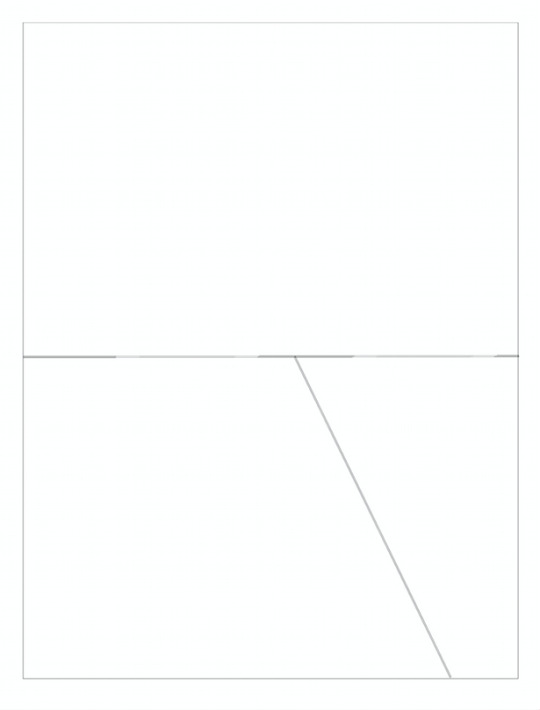
Ways to explore space:
Overlapping: When one object is positioned in front of another object, blocking its full view; this is called overlapping. The overlapping creates the illusion of space.
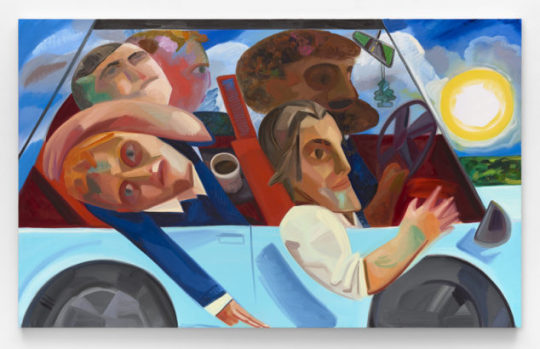
There is no difference in the size of the figures, but we understand their respective positions establish a sense of depth.
Dana Schutz



Position in the Field: Where things are positioned in the field of view also create space. Generally, objects that are positioned lower on the picture plane will appear closer than objects that are positioned higher on the picture plane.

Tom Wesselmann, Still Life #12

Image above: Nancy Gail Ring, Souls 2010

Size: The range in size of an object also creates space. Objects that are closer to a viewer appear larger than objects that are further off in the distance - this is something that we learn very early on in life.
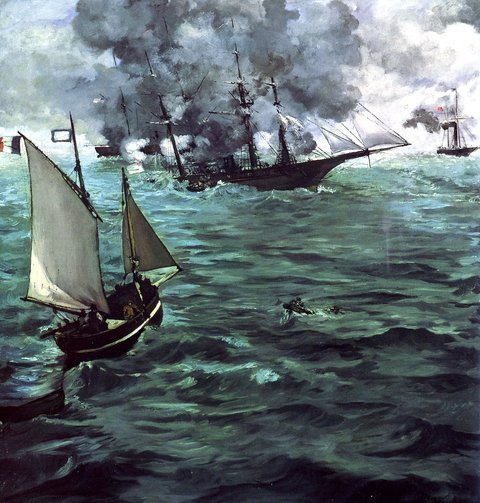
Edouard Manet
Immediately we see the relative sizes of various elements and understand space is suggested. This flat picture plane becomes a window through which we see a 3D scene.

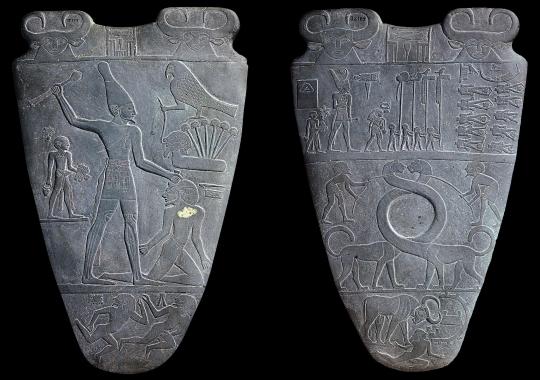
Narmer Palette
Hieratic Scaling: Size historically has been sed to denote some conceptual importance rather than to dictate spacial depth.
Amplified Perspective/Foreshortening: Amplified perspective is used to create a dramatic, dynamic quality. This occurs when an element of the composition is pointed directly at the viewer. The amplified area becomes the most eye-catching area of the composition. Everything else seems to recede immediately.
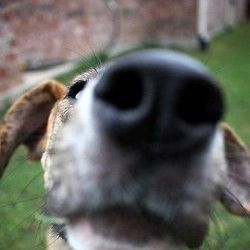
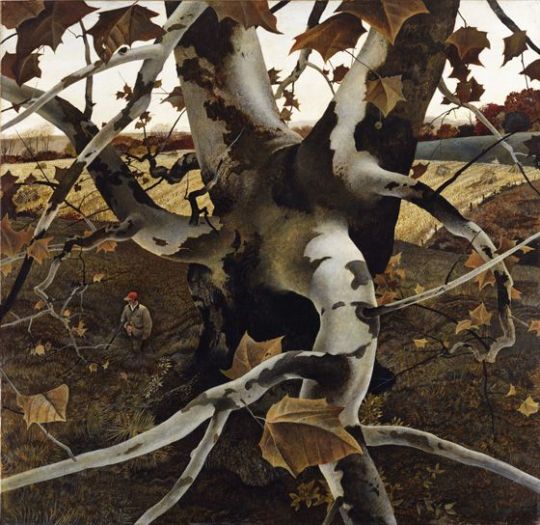
Andrew Wyeth
Linear Perspective: Linear perspective is a complex spatial system based on a relatively simple visual phenomenon. As parallel lines recede, they appear to converge and meet on a n imaginary line called the horizon (or eye level). Consider a road or railway tracks that stretch off into the distance. Artist during the Renaissance first introduced the idea of a vanishing point on the horizon to convey this idea on a 2D surface. This is a way artists can reproduce what the eye sees.
There are several different ways to create space using linear perspective. One-Point Perspective, Two-Point Perspective, Three-Point Perspective.
*Again, perspective as an idea and technique is a human invention. It is a technique and tool that can be used to create an incredibly realistic illusion of three-dimensional space on a two-dimensional surface. Renaissance architect Filippo Brunelleschi is credited with inventing one-point linear perspective around 1420, which revolutionized painting and paved the way for naturalistic styles to develop as the Renaissance digressed from the stylized figures of medieval art.
One-Point Perspective: a mathematical system for representing three-dimensional objects and space on a two-dimensional surface by means of intersecting lines that are drawn vertically and horizontally and that radiate toward one point on a horizon line.

Rules of perspective: true shapes, vanishing points and horizon lines
In one-point perspective, surfaces that face the viewer appear as their true shape, without any distortion. They are drawn using primarily horizontal and vertical lines.

Surfaces that travel away from the viewer, on the other hand, converge towards a single ‘vanishing point‘. This is a point that is located directly in front of the viewer’s eyes, on a ‘horizon line’ (also known as an ‘eye level line’), as illustrated in the photo below (and above):
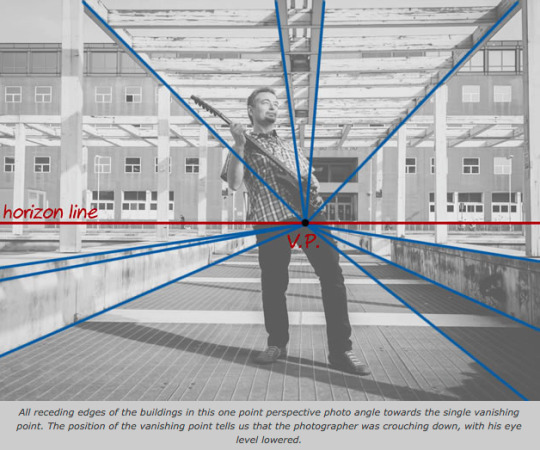
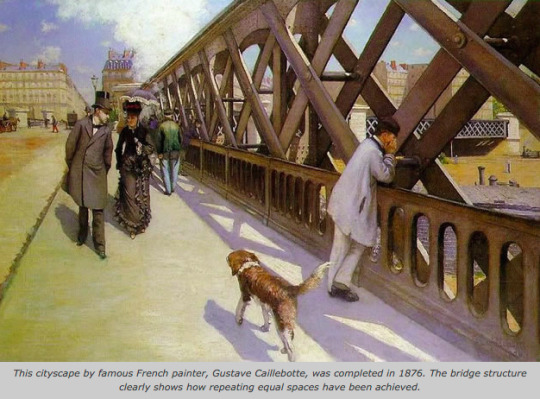
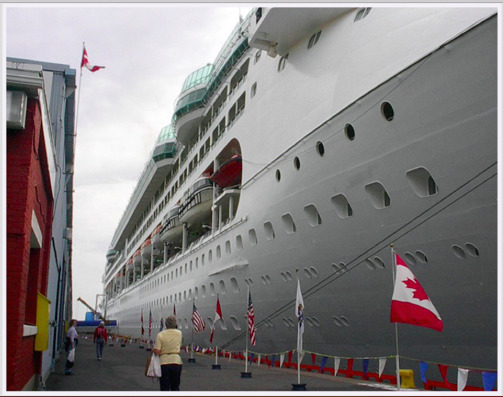
...and in photography.
Two-Point Perspective: Two-point perspective is the same definition as above except that the intersecting lines that are drawn vertically and horizontally radiate toward two points on a horizon line. This way we can “view” from an angle. This might feel more true to life.



Three-Point (Multipoint) Perspective: This type of perspective usually shows three sides of object (generally from above or below). Three-point perspective has three vanishing points (a third from above or below). This type of perspective usually shows three sides of object. This is useful to suggest ideas of height.


Atmospheric Perspective: Space is created through the change of value (light and dark) to show depth. As the value decreases toward the horizon line the illusion of space is created. This also creates a contrast in the composition.


This can occur graphically or photographically

Atmospheric perspective can also give the viewer a sense that they are floating or not help down by gravity.

Similarly, Depth of Field: (DOF), also called focus range or effective focus range, is the distance between the nearest and farthest objects in a scene that appear acceptably sharp in an image. Although a lens can precisely focus at only one distance at a time, the decrease in sharpness is gradual on each side of the focused distance, so that within the DOF, the unsharpness is imperceptible under normal viewing conditions.

The change in focus creates space.
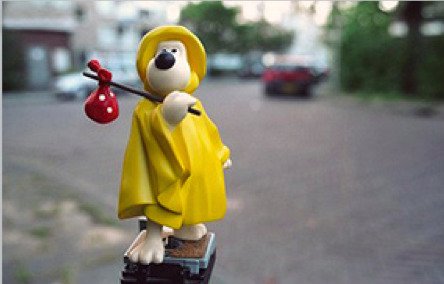
The area in focus can occur in the foreground....

....or in the background.

Equivocal Space: When two forms overlap and both are seen completely and This type of perspective usually shows three sides of object transparency is assumed. Spatial interest is increased by using transparency in many places so that forms can get interpreted (what is on top or behind) rather than the obstructions found with overlapping.

Dana Schutz

Andy Warhol
SPACE PROJECT
For this lesson your classroom practice will be instrumental in producing your homework project. In class we will do a digital story boarding assignment. Your class work will then be analyzed and translated into a Triptych homework project.
Creating Space Story Boarding Classwork

A storyboard is a graphic organizer in the form of illustrations or images displayed in sequence for the purpose of pre-visualizing a motion picture, animation, motion graphic or interactive media sequence. For the purposes of this class your story board will be used to create your Triptych homework project.
For todays classwork you are to conceive of a story or narrative. The visual progression of your story will be explored through the story boarding process. You can be an original story OR you can choose to re-tell an existing story. You must adjust your narrative so that you limit the story to SIX spaces.
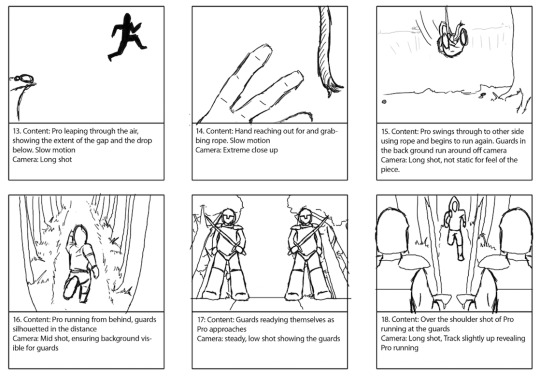

In order to maximize your story and tailor it to this assignment you will need to potentially edit your story down - perhaps zoom in on one situation from the story. Each particular story board must also specifically apply one of the space creating techniques discussed in class from the above. You are to work out the story board options digitally using Illustrator. You must post each storyboard and describe what type of space you are intending to create.
As the artist you have complete and total control of all aspects of the story; the story line, characters, scenery, location, and events. If you are retelling a story that already exists in graphic, comic, animation or film form you can not copy or replicate any characters invented by another artist. This means that if you are telling part of Disney’s Frozen you can not have a character that looks like Elsa.

You will have to invent your own character.
Homework: Space Triptych Project
For the homework you are to re-imagine your narrative story board so that the main gist of the story is expressed in three still images (panels). Make sure you apply your space techniques into this project (this project is about space!). All three panels must be 50/50 digital to hand-ons and mounted on bristol. You must kill the white of your composition - fill your entire compositions. Finished work will be turned in for class critique and also posted to your blog.
No text: How do you convey a story through only image?
In order to understand the homework we first need to take a look at the definition of a triptych.

Max Beckmann, Triptych of the Temptation of St. Anthony,1937, Oil on Canvas
A triptych: is a work of art (usually a panel painting) that is divided into three sections, or three carved panels which are hinged together and can be folded shut or displayed open. It is therefore a type of polytych, the term for all multi-panel works. The middle panel is typically the largest and it is flanked by two smaller related works, although there are triptychs of equal-sized panels.

Robert Campin, and assistant, The Annunciation Triptych (Merode Triptych), Metropolitan Museum of Art, New York, about 1625-30
The triptych form began in early Christian art, and was a popular standard altar painting format from the Middle Ages onward, both in Europe and elsewhere, altarpieces in churches and cathedrals were often in triptych form. Renaissance painters such as Hieronymus Bosch used the triptych form.
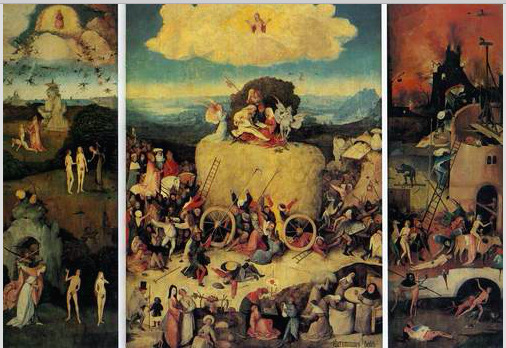
Heronimus Bosch, The Haywain, Oil on wood 135 x 190 cm Museo del Prado, Madrid, Spain
Although strongly identified as an altarpiece form, triptychs have been also been created by Max Beckmann, and Francis Bacon among others. Modern triptych works have typically been developed as three separate pieces that work together. Modern artists have also altered the triptych by making all panels equal in size.
I would like you all to follow the modern version of the triptych format and make each panel a separate piece (do not connect them). You will need to decide how your triptych will function, will it be three equal size works or will sizes vary depending on your story.
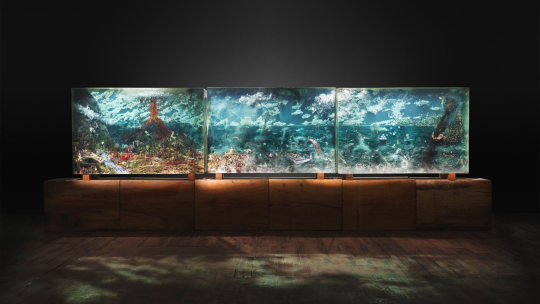
Dustin Yellin’s “The Triptych”
For a detailed video montage: https://www.youtube.com/watch?v=2mYqky99i_w

Max Beckmann “Departure” 1932-33 Oil on canvas Triptych, center panel 84 ¾ X 45 3/8”; side panels each 84 ¾ X 39 1/4” The Museum of Modern Art, New York
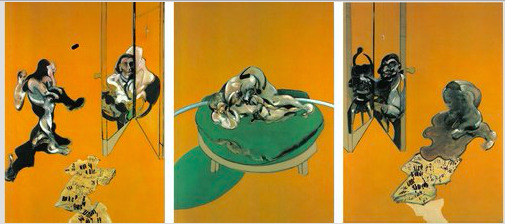
Francis Bacon, Three studies of the male back triptych 1970, Oil on canvas, each 198x147.5cm Kunsthaus Zürich, Vereinigung Zürcher Kunstfreunde
Student Examples
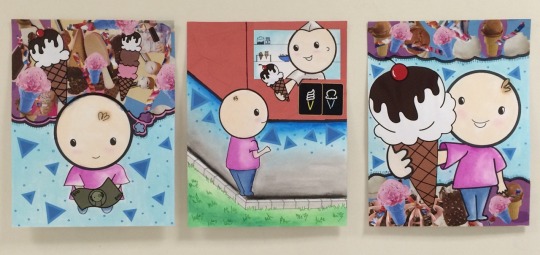
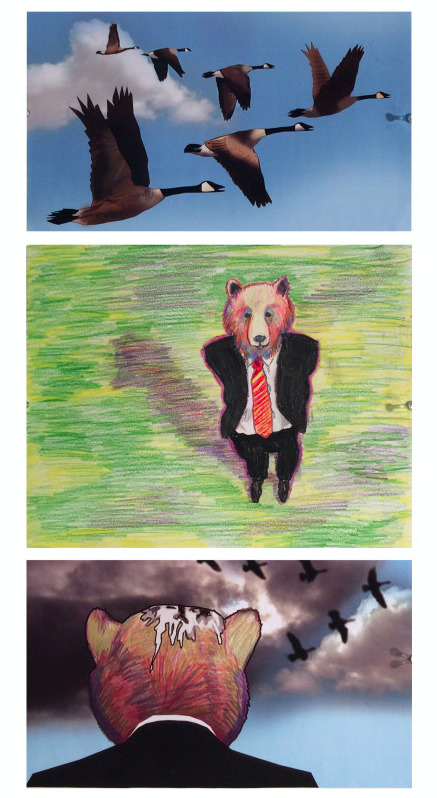



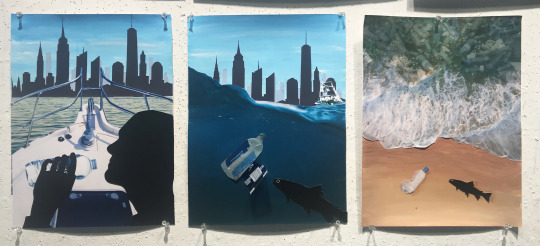
3 notes
·
View notes
Photo

Artist spotlight: Mia Marjorie!
✿ Commissions ✿
Tumblr ✿ Instagram
Header source: [X]
Introduce yourself
I'm Mia, I'm an amercan Artist currently living in the Philippines. I have always had a deep passion for art and sciences, particularly botany and astronomy. I'm a huge animal lover, especially of cats and snakes. I draw lots of original content, but dip into homestuck fanart as well for the nostalgia™.
When did you start drawing? Are you a digital or traditional artist?
Ive been drawing since before I could walk. I do both digital and traditional art.
Which mediums are your favorites? Did you try going digital?
My favorite mediums are graphite, oil paint, watercolor, and ink.
Why do you prefer traditional over digital? (or viceversa)
I like them equally! I like that digital art is very easy to share and that there's so much potential for creativity. I like traditional art because of the visceral experience of holding, feeling, and touching the art I also like it because i can be unplugged.
What do you think is the most challenging part about being a traditional/digital artist?
The most challenging part of being a digital artist is getting used to the software you're using, and deciding what software and hardware to use. The hardest part of traditional art is finding the right materials, and learning new mediums.
What inspires your pieces?
My pieces are mostly inspired by my spiritual experiences, dreams, and things i find beautiful. Some are inspired by fandoms such as homestuck, mario bros, and pokemon.
Explain your "everyday" drawing process
I put on a podcast(i love whomsically volatile and tiny meat gang at the moment), or some music. Then i get my computer and tablet set up, or i gather my materials. I usually draw on my bed, unless im painting, which i do on the floor. I usually have snacks with me, and take frequent breaks for searching references and resting my hands. Thhen when im done, i share it.
Do you have an artist you admire (or more than one)?
I love @kelseyjbeckett on instagram. Her oil paintings are so beautiful. I also love @baotpham and @jaquelinedeleon
Is there an artwork you are most proud of? Why?
Im really proud of this one https://drive.google.com/open?id=1yn6ziVqSX-j_F6QvDgAAkw3SekN1MLy3 because i spent a lot of time on it and i like the colors and details.
Do you listen to music (or tv shows/films/anything else) when drawing?
I listen to the tiny meat gang podcast by cody ko and noel miller, and whimsically volatile by katya zamolodchikova and craig. Sometimes i watch that 70's show. I also listen to coven, system of a down, lana del rey, red hot chili peppers, and a lot more.
What makes art interesting for you?
There is infinite potential creatively. Literally anything is possible. It's also very stimulating for the brain, especially because there's learning involved, which is my favorite thing ever.
What do you do when art block strikes?
I usually go on instagram to look at what the artists i follow are doing, or watch youtube videos or movies.
What’s the most valuable art advice you’ve ever received?
The most valuable art advice i have ever recieved was to study anatomy.
2 notes
·
View notes
Photo

Tonight’s drawing practice. WIP. I am not over this.
#If this is episode one what will the rest be like!?#loki#loki series#loki art#my art#loki fanart#fanart#spoilers#i guess#digital art#Del learns digital painting
45 notes
·
View notes
Text
I was tagged by @markired who I absolutely adore 🥰
rules: answer 21 questions and tag 21 people you want to get to know better. (make a separate post)
1. Nickname: Val, Vale, Valy, Valerie (because my name is Valeria so) Lita (Because wrestling runs in my blood)
2. Zodiac: Aquarius (January 29) ♒️😌✌🏻
3. Height: 5’7
4. Last movie I saw: I believe it was The Punisher’s War Zone because I wanted to compare it with the next Punisher season.
5. Last thing googled: “What can I do with cherries?”
6. Favorite Musicians: My Chemical Romance, Lady Gaga, Brendon Urie, Green Day, Fall Out Boy, Billie Eilish, Marina and The Diamonds, Ruelle, Digital Daggers, Stevie Nicks, Natewantstobattle, Ninja Sex Party, Queen, Lana del Rey, Rynx (totally didn’t left some of the ones Kylo put in hers because we have same favorites xD)
7. Song stuck in my head: Gosh this “Run To You” by Lacey Sturm, I’ve been listening to it none stop xD
8. Other blogs: none, I deleted them all 🤷🏼♀️
9. Do I get asks: barely, and I’m ok with that, actually xD
10. Followers: somehow 899, somehow
11. Following: 310 🤟🏻
12. Amount of sleep: ha, sleep, what is that I’m a vampire 😂 like barely 6 hours, sometimes 8, sometimes.
13. Lucky Number: uuuuhhh 9? I don’t have one
14. What I’m wearing: a grey tank top and a gypsy long gold and black skirt.
15. Dream Job: Producer, Singer, screenwriter, for sure.
16. Dream Trip: The Wizardly World Of Harry Potter in Orlando for damn sure without any hesitation or doubt in my mind.
17. Favorite Food: PIZZA 🍕
18. Play any instrument: the flute, used to play it at school, wanna learn piano and violin tho.
19. Favorite Song: Helena by My Chemical Romance 🧛🏻♀️
20. Random Fact: I’ve been self learning how to sing and I think I got it but I’m to shy to actually show anyone 🤷🏼♀️
21. Describe yourself as aesthetic things: vampires, red and black bed sets, neon paint, calligraphy pens, hardcover notebooks, Skullcandy headphones, pink Razzer setups, purple candles, ankle bracelets, rings, black nail polish, purple Christmas lights, purple in general.
I’ll Tag: @sarcastic-crustacean @hopeypuff94 @februaryfun @fischyplier @fear-is-nameless @elegantdreamer @secretaryofthevoid-exe @oi-fischfuck @prettydoddleoddle @stormpil0t @jacksoopticboop @jacksinsanity @lisassp @viostormcaller @bekadmfb and whoever else wants to play, consider yourself tagged by yours truly ;)
8 notes
·
View notes
Photo




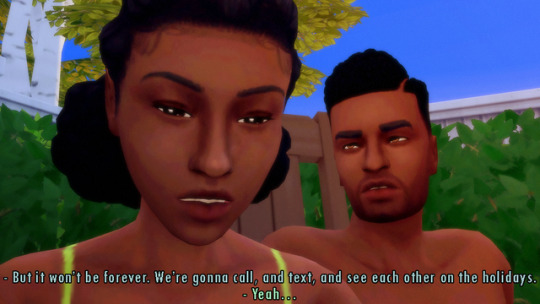
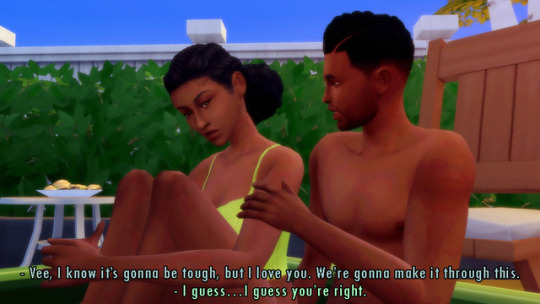
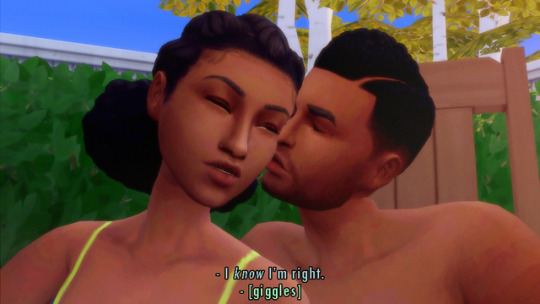

With Indigo now soundly inside our house, Noah turned to me and asked what had me so entranced. I had been doing that mile-long stare for a while now. It used to only happen periodically when I thought upon our futures for a little too long, but these days, it was hard to catch me not completely swallowed by the void mid-conversation.
Del Sol Valley. That’s where I would be headed in the next few days. It had been a big shock when I received my admissions decision; not only had I got into one of the most competitive drama programs in the country, I had received a near full tuition scholarship as well. My dad had helped me figure out what I would need for the move and had my bulkier items shipped in advance for my dorm. I would be following them shortly after on the plane ride.
Alone.
While I would be pursuing a degree in performing arts at Del Sol University, Noah would be studying fine arts with a concentration in visual arts at the San Myshuno Institute of Arts. His acceptance letter came in only a day before mine. I added another item on my list of why August sucked: it was when I would be forced to leave my boyfriend behind to go to colleges 3,000 miles apart.
Previous | Next | Beginning
Okay, so I wasn’t really being forced; the reality was that this was my dream. I had been doing school plays since middle school, and from the very first time I got a standing ovation while playing Maria from West Side Story, I knew that I wanted to live in that feeling forever. Becoming someone else on the stage, breathing life into the dialogue, bringing the audience to tears; it felt like I had been made for this. And Del Sol Valley was ground zero for the acting industry. If I wanted to make the best connections, book the best auditions, and live in the best atmosphere for what I hoped would become my career, there was no better place than that sunny, west-coast city where stars were born.
It was similar to how Noah felt about San Myshuno. The Institute was nestled right in the heart of the Arts Center, which had a long history of breeding the most notable creatives in the country, from the historical SanMy Renaissance of the early 20th century, to the rise of street art in the 80s and 90s, to the recently popularized minimalist styles of this century. He would be taking courses instructed by some of the most notable visual artists of the day learning both classical painting with oils, watercolors, and acrylics, and his preferred medium of graphite sketch. I was so happy that he was getting such a huge opportunity, but undeniably heartbroken that it meant we would be living on two sides of the country for most of the year. We’d agreed to stay together; long-distance wasn’t ideal, but neither of us could see not being together anymore. Our love was too perfect to throw away at the first bump in the road. But of course, it still scared me, and it was hard not to let that fear take over especially now that our final days were upon us.
Noah’s soft, warm lips pressed against my cheek brought me back. He had been amazing these past few months, wasting no time to make every moment count. It made my heart ache a little again to think about what a perfect life I was leaving behind. But I also felt warm in his arms. We were gonna make it through this.
Indigo returned after that, carrying not only three beers, but her new camera. It had been a graduation present from our dad and an upgrade from the cheaper digital camera she’d used for her photography club activities up to that point. As psyched as she was to use it, she’d also been extremely careful, afraid of tragedy striking and destroying it before she even moved in to her dorm. She set it down gingerly on the table and then handed us each a bottle.
Ivy: I’m surprised to see you handling that around liquid. I thought you’d keep it in the case for the next four years just out of sheer nerves.
Indigo: Ha ha. I figured it would be a shame not to use it at least once before we leave. I want to get some good shots of us all as we were before college to look back on when we’re graduating.
Noah: What a concept. Actually using your camera to take pictures. [chuckles]
Indigo: On second thought, you can leave.
Noah: You can’t kick me out.
Indigo: It’s my house.
Ivy: And mine.
Indigo: [rolling her eyes] Details, details. You want a nice picture to post to your Simstagrams or not?
Ivy: [giggling] Alright, alright, set up your camera already.
#sims 4#sims 4 story#sims 4 gameplay#sims 4 get famous#ts4#ts4 story#ts4 gameplay#ts4 get famous#the sims 4#the sims 4 story#the sims 4 gameplay#the sims 4 get famous#simblr#black simblr#sims of color#and then they kissed#thelivinglensims#thelenssims#lily of the valley#lily of the valley chapter 1#ivy#noah
15 notes
·
View notes
Text
Extraordinary Tales

I was browsing Netflix for some horror or halloweenish things to watch this season, when I stumbled across Extraordinary Tales, an anthology film with segments based on the works of Edgar Allen Poe. I don’t consider myself a fan of Poe’s work, but it was always a pleasure when I had to read his stories for class. So I turned it on and...oh my god.
Animation people, why aren’t we talking about this?!
This was fuckin’ gorgeous! Incredibly haunting and disturbing, yes, but gorgeous!
Each segment has its own unique style, and each one is narrated by a different person.
I’ll just go through one by one.
0) Poe and Death

To start, the thing that connects these shorts together. We see a raven flying around a cemetery, whom we learn is Edgar Allen Poe. He has a converstaion with the personification of death, who says he’s obsessed with her. Each story is being retold as Poe tries to show his writings were more than just love letters to death.
1) Fall of the House of Usher

This story is narrated by the late great Sir Christopher Lee. I will admit, I’m not super familiar with this story (I read it for class, but I’ve slept since then), but nevertheless the presentation in this story is amazing. It has an almost Burtonesque look to it, and you can see the cracks in the building grow larger as the story progresses. Also, the narrator reminds me of human Blinky from Trollhunters. I don’t know why.
2) The Tell-Tale Heart

Now this story I do remember. I read it in 9th grade, and it’s a chilling story I never forgot. It’s probably my favorite story from Poe. And this short has reignited the fear the original story stoked into me. Using archival audio, the segment is narrated by Bela Lugosi (If you don’t recognize his name, he’s best known for his role as Dracula in the 1931 film of the same name). This audio is not digitally restored in any way, so it sounds crackily and warped with age. And his narration paired with the visuals is incredibly unnerving. The short is mainly in black and white with no blending. The only other color used is red, and even then it’s used very little, it never fills the screen. This makes the short even more creepy looking. The Old Man, even though he’s the innocent victim in all this, is terrifying to look at! He’s really creepy! It’s just all around creepy, and it’ll probably keep me up tonight.
Speaking of keeping me up tonight...
3) Facts in the Case of M. Valdemar
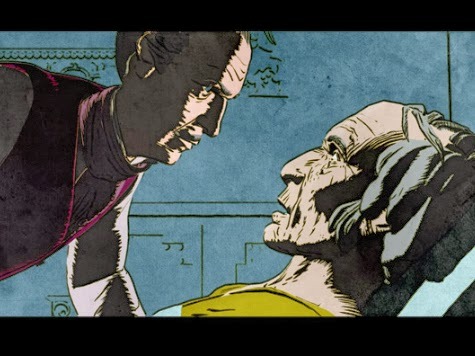
...This will also haunt my nightmares! I had never heard of this Poe story before, it feels more like something Mary Shelley might’ve wrote! This segment is narrated by Jullian Sands (whose most notable movie from what I can see is Arachnophobia). The style takes after comic books, almost reminiscent of the animation used in Telltale’s games (ah hah, Edgar Allen Poe, Telltale, hardee har). The narrator of the story is very obviously modeled after the late Vincent Price, which made me wish he was the narrator. I mean, there’s so many recordings of Vincent Price reading Poe’s stories that they could’ve had him narrate one of these segments (I distinctly remember hearing him read Pit and the Pendulum while on a road trip, but I’ll get into that later...) But, for what we got, Sands is a pretty good narrator. This was my first time hearing this story, so I was not prepared for what was in store. Monsieur Valdemar’s lifeless body acts like it’s in the Exorcist (minus the crucifix masturbation, spider walk, 180 degree head turn, and the pea soup). And did you think the way Magica possed Lena in DuckTales ‘17 was disturbing? Oh ho! take that, ramp the graphicness of it up to 11 and you get what happens after Valdemar is snapped out of his “trance”. It is horrifying!
4) The Pit and the Pendulum

This is the only segment that tries to look realistic. The other segments go for more stylized looks, which are incredibly affective. This one looks like a video game. I’m not saying it’s bad, that’s just what it reminds me of. Anyway, this story is narrated by Guillermo “Where’s-My-Haunted-Mansion-Remake” Del Toro, which is good casting. The story takes place during the Spanish Inquisition, so his accent helps illustrate that. I didn’t even know this story took place during the inquisition, I only heard Vincent Price narrate part of it during a family road trip. I don’t remember if I plugged in my headphones and zoned out or if I asked my dad to change the station (random fun fact: I’m really unnerved by audiobooks and radio dramas. It doesn’t matter if the story is funny or not, they creep me out. Probably stems from a creepy audiobook we listened to in elementary school or my dad listening to disturbing radio dramas late at night during long road trips) Only thing that doesn’t work is that Del Toro’s words don’t match the visuals. He says that following the wall didn’t help him figure out his surroundings, but the visuals show him looking out a barred window. How did that not help you figure out your surroundings? I think this short might’ve benifited from cooler colors. The story is meant to take place in a dark cell, the narrator can barely see anything. The animation is very red in this segment, not conveying this sense of darkness we should be feeling. It only goes to blues and cooler colors when night falls, but I think it would’ve been better if the rest of the short was like that.
5) Masque of the Red Death
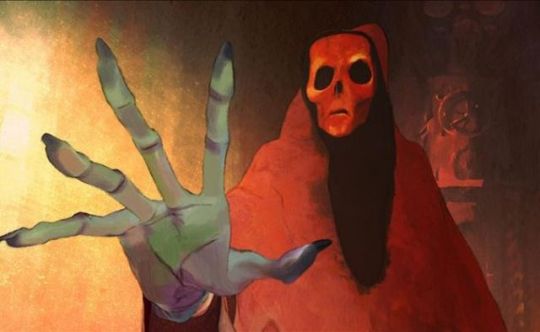
The final segment of the film. This one is unique from the other ones because it has no narrator. There are only two lines said in this short (one spoken by Roger Corman), the majority is told visually. And...I don’t think it works very well...? I have never read this story, the most I know is that it’s about the Plague and that the Phantom of the Opera has a killer Red Death cosplay. You kinda get what’s going on...? The poor are dying from the plague, the rich are hiding behind a wall to keep them from getting infected, but the Red Death gets in and kills everyone. Most of the short is just watching these people party. It’s like you’re the only sober person at this shindig and you’re antisocial as fuck (so... in my case, real life). It doesn’t get interesting until the Red Death shows up, then it’s like Oprah. “You get the plague! And you get the plague! EVERYBODY GETS THE PLAAAAAAGUE!!!” And then, it ends. Uhh, okay?...what was I suppose to gain from that? I mean, the animation is pretty, made to look like a painting. But outside of eye candy, what else is there...? Maybe if I read the story, this would make more sense to me and I wouldn’t be so harsh towards it, but a film should be able to stand on its own. I shouldn’t have to read the story to understand what’s going on, that’s your job! You’re suppose to tell the audience the story! Not rely on them to have done their homework that they didn’t even know was assigned! That’s basically how this last segment felt; it felt like when I forgot to do the reading assignment for class and the teacher starts discussing it like everyone has read it, while I’m sitting there going “...whut...?”
Conclusion
This was a mixed bag for me. The segments were either hit or miss, but the ones that hit, hit really damn hard. And even the ones that miss still had some redeeming qualities, whether it was the animation or the narrator.
If I had to rank the segments from my favorite to least favorite, it’d be like this;
😄Tell-Tale Heart
🙂Facts in the Case of M. Valdemar
😐Fall of the House of Usher
😕Pit and the Pendulum
☹️Masque of the Red Death
Maybe my opinions would be different if I had read all these stories prior to seeing this film, but as someone who’s only dabbled in Poe’s work for school, I still really enjoyed this. I mostly appreciate it as a fan of animation. Each segment does something different, giving each story a unique style.
If you’re looking for a macabre film to watch this Halloween, give Extraordinary Tales a watch...
...just make sure you do so with the lights on...
...Goodnight, and pleasant dreams...

#film review#opinion warning#extraordinary tales#edgar allan poe#fall of the house of usher#tell tale heart#facts in the case of m valemar#pit and the pendulum#masque of the red death#halloween
25 notes
·
View notes